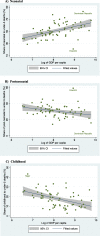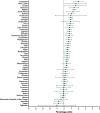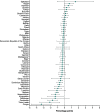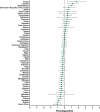Distribution of under-5 deaths in the neonatal, postneonatal, and childhood periods: a multicountry analysis in 64 low- and middle-income countries
- PMID: 33902593
- PMCID: PMC8077916
- DOI: 10.1186/s12939-021-01449-8
Distribution of under-5 deaths in the neonatal, postneonatal, and childhood periods: a multicountry analysis in 64 low- and middle-income countries
Abstract
Background: As under-5 mortality rates declined all over the world, the relative distribution of under-5 deaths during different periods of life changed. To provide information for policymakers to plan for multi-layer health strategies targeting child health, it is essential to quantify the distribution of under-5 deaths by age groups.
Methods: Using 245 Demographic and Health Surveys from 64 low- and middle-income countries conducted between 1986 and 2018, we compiled a database of 2,437,718 children under-5 years old with 173,493 deaths. We examined the share of deaths that occurred in the neonatal (< 1 month), postneonatal (1 month to 1 year old), and childhood (1 to 5 years old) periods to the total number of under-5 deaths at both aggregate- and country-level. We estimated the annual change in share of deaths to track the changes over time. We also assessed the association between share of deaths and Gross Domestic Product (GDP) per capita.
Results: Neonatal deaths accounted for 53.1% (95% confidence interval [CI]: 52.7, 53.4) of the total under-5 deaths. The neonatal share of deaths was lower in low-income countries at 44.0% (43.5, 44.5), and higher in lower-middle-income and upper-middle income countries at 57.2% (56.8, 57.6) and 54.7% (53.8, 55.5) respectively. There was substantial heterogeneity in share of deaths across countries; for example, the share of neonatal to total under-5 deaths ranged from 20.9% (14.1, 27.6) in Eswatini to 82.8% (73.0, 92.6) in Dominican Republic. The shares of deaths in all three periods were significantly associated with GDP per capita, but in different directions-as GDP per capita increased by 10%, the neonatal share of deaths would significantly increase by 0.78 percentage points [PPs] (0.43, 1.13), and the postneonatal and childhood shares of deaths would significantly decrease by 0.29 PPs (0.04, 0.54) and 0.49 PPs (0.24, 0.74) respectively.
Conclusions: Along with the countries' economic development, an increasing proportion of under-5 deaths occurs in the neonatal period, suggesting a need for multi-layer health strategies with potentially heavier investment in newborn health.
Keywords: Distribution of under-5 deaths; Heterogeneity across countries; Low- and middle-income countries.
Conflict of interest statement
The authors have no conflicts of interest relevant to this article to disclose.
Figures




References
-
- WHO . Child mortality rates plunge by more than half since 1990 but global MDG target missed by wide margin. WHO; 2015.
-
- World Health Organization. Newborns: reducing mortality. Available from: https://www.who.int/news-room/fact-sheets/detail/newborns-reducing-morta.... [cited 2020 Feb 4].
-
- WHO | Neonatal mortality: trends 1990–2010. WHO. 2011; Available from: https://www.who.int/maternal_child_adolescent/topics/newborn/neonatal_mo.... [cited 2020 Feb 4].
-
- Judkins A. Global neonatal mortality – can we do more? Pediatrics. 2018;141:466. doi: 10.1542/peds.2017-0725. - DOI
Publication types
MeSH terms
LinkOut - more resources
Full Text Sources
Research Materials

